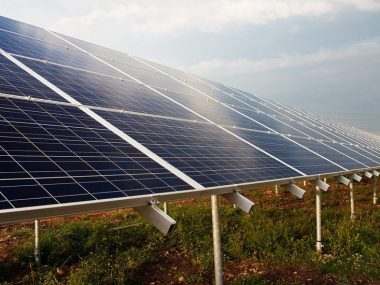What is solar battery?
A solar battery also known as a solar storage battery or solar energy storage system, is a device used to store energy generated by solar panels or solar arrays. Solar panels produce electricity when exposed to sunlight, but this electricity is often generated intermittently, depending on weather conditions and time of day.
Solar batteries store excess electricity generated during sunny periods for later use, such as during the night or when the sun isn’t shining. This stored energy can then be used to power homes, businesses, or other electrical devices when solar panels aren’t producing electricity.
The solar battery is an important part of the solar photovoltaic system. It is responsible for storing the electrical energy converted by the solar panels.
Types of Solar Batteries and Their Charging Times
Solar battery is a rechargeable battery. It supports deep discharge and high cycle times.
Gel battery, lead-acid battery, lithium-ion battery are the most common energy storage batteries. They have different charging and discharging duration.
Let’s compare with similarly sized photovoltaic batteries.
Lead-acid batteries
Charge slowly, It usually takes 8-10 hours for a full charge.
Lithium ion batteries
Charge a little faster during the day, It can take 7-8 hours to fully charge.
AGM batteries
Charge and discharge slowly, similar to lead-acid batteries.
How to Check if Solar Battery is Draining?
After a period of use, you may have an idea of how long a fully charged battery can last, and if the current battery does not last as long as expected, then there is likely to be a problem of excessive battery draining.
To check whether your solar battery is draining, you can use a multimeter to monitor the power output of your battery.
Another way to check is to use solar controller and inverters. They are connected to the battery in real time and can check the status of the battery.
and if it is draining, it will show up in what they’re reading.
What Causes Solar Battery Draining?
There are many reasons why a solar battery may drain too quickly.
Several factors can contribute to the rapid drainage of solar batteries. Understanding these reasons can help address issues and optimize battery performance in solar energy systems. Here are some potential reasons why solar batteries may drain quickly:
Charge Controller Issues
A charge controller is used to limit the speed of power being added to or removed from the batteries.
It automatically switches from charging the batteries to maintaining their charge. If it malfunctions, it can affect the battery bank’s capacity to hold a charge and no warns when the battery drains.
Your Battery is damaged
While solar battery failure can be caused by a number of factors, overcharging, under charging, and sulfations.
Battery damage can also cause the battery to fail to charge and discharge too quickly.
Extreme Weather Condition
Extreme weather conditions such as rain, snow, or cloud cover can reduce solar power generation and drain batteries faster than usual.
Parasitic Draw
Solar batteries can be drained quickly because of a phenomenon called “parasitic draw”. This occurs when an appliance is in standby mode and continues to draw power, even when it is shut off.
For example, solar batteries can be drained quickly by a television or other type of electronic device that is in standby mode and continuously consuming power.
Parasitic draw is particularly problematic for people who rely on solar power for their appliances.
Internal Problems
Over-discharging is a common issue that can occur in solar batteries. Over-discharging can lead to battery overheating and failure. Low output voltage, low current, and sulfation are common internal problems that can lead to battery depletion.
Overheating
Overheating can lead to battery failure. If the battery gets too hot, it may cause cells to rupture, leading to a loss of electrolyte and eventually, cell ignition.
Too Long between Battery Recharges
Charging and discharging batteries can cause battery drain if solar panels are not compatible with the battery type or if not enough power is generated from the solar PV.
Not Enough Charge
A battery can be partially drained if the solar panels capacity is not sufficient to charge it fully during the day.
You should recharge batteries at 50% for lead acid batteries and 35%-40% for lithium batteries, and 85%-95% to use the battery for longer periods.
Not Using a Charge Controller
A charge controller is a vilal component to solar battery system, regulating voltage and current to ensure that batteries get charge and not overcharge.
It is critical to use a charge generator to protect them from overcharging and ensure they operate at their best capacity.
without a charge controller solar batteries may discharge faster than they are able to recharge, causing the internal charging system to wear out quickly.
Putting a Fully Discharged Battery in Storage
A battery should never be fully discharged or charged when stored for long time.
It is recommended to keep the battery at 85% full when stored. Discharging a battery too much can damage the battery cells and reduce its life span.
Poor Battery Maintenance
Overcharging and undercharging of a battery can lead to battery failure and eventual draining.
Poor battery maintenance can lead to battery drain.
Increased Load
Over-discharge is an important issue with solar batteries, especially when they are used to store power from solar panel.
The high load of solar batteries can lead to faster discharge, resulting in a drop in voltage levels below a preset threshold.
This over-dis discharge can dramatically reduce battery life and ultimately cost savings.
Defective Charge Controller or Inverter
A defective charge controller or inverter can lead to voltage spikes and dips, which can disrupt the battery charge or drain the battery without cutoff. This in turn may lead to damage or loss of battery capacity.
Aging
Solar batteries, like other types of batteries, are affected by aging degradation.
The performance of a solar battery can degrade with time due to factors such as discharge and charge cycles, over-discharging, and short-circuiting.
How to Prevent Solar Battery Drain?
To prevent energy from being wasted, you can also utilize a high quality solar charge controller. This will help you control the amount of solar power flowing into the battery, preventing it from overcharging or undercharging.
Low voltage Disconnect Unit also helps protect battery from drain fast
Also preventing solar battery drain involves a combination of proper system design, maintenance practices, and energy management techniques. Here are several strategies to help minimize solar battery drain:
Proper Sizing:
Ensure that your solar battery system is appropriately sized for your energy needs. Oversized systems can lead to unnecessary expenses, while undersized systems may not provide sufficient backup power.
Efficient Energy Use:
Implement energy-efficient appliances, lighting, and electronics to minimize energy consumption. This reduces the demand on your solar battery system and prolongs its battery life.
Optimize Solar Panel Placement:
Install solar panels in locations with maximum sunlight exposure to maximize energy generation. Proper orientation and tilt angle can significantly impact the efficiency of solar panels.
Tips to Make a Solar Battery Last Longer
When using solar power, charge the batteries fully before using them. This will provide the batteries with more power than they would normally have and ensure that they last longer.
Regularly clean the solar panel to ensure optimal performance and longevity.
Use interconnect cables of proper size to maximize power transfer between the solar panel and battery.. This will allow for increased efficiency and power output, which could prolong battery life.
Use distilled water as an additive to improve the electrolyte in your battery cells, which could also help increase its lifespan.
Lastly, equalize your battery by a ZHCSolar battery balancer.
How to Replace Solar Battery Diodes and Fix Draining
If you notice that your solar battery is not holding a charge as long as it should, you may have just one issue – solar battery diodes.
These are the essential components of solar batteries that convert the solar power into DC power for charging batteries.
To fix solar battery draining issues, you need to replace solar battery diodes with high-quality ones. Higher-quality solar battery diodes can withstand greater voltage and current than the cheaper variants











